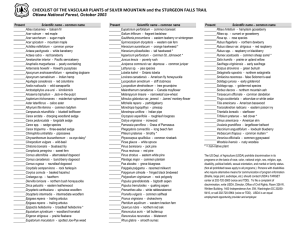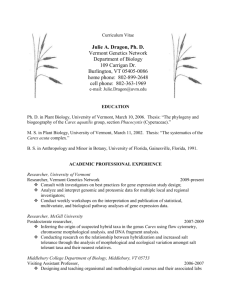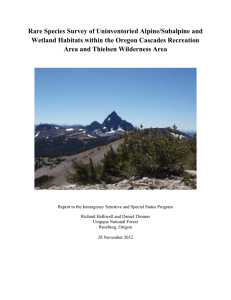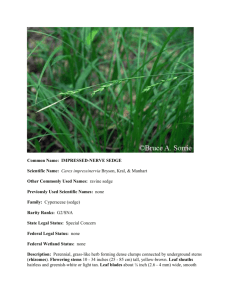Carex
advertisement
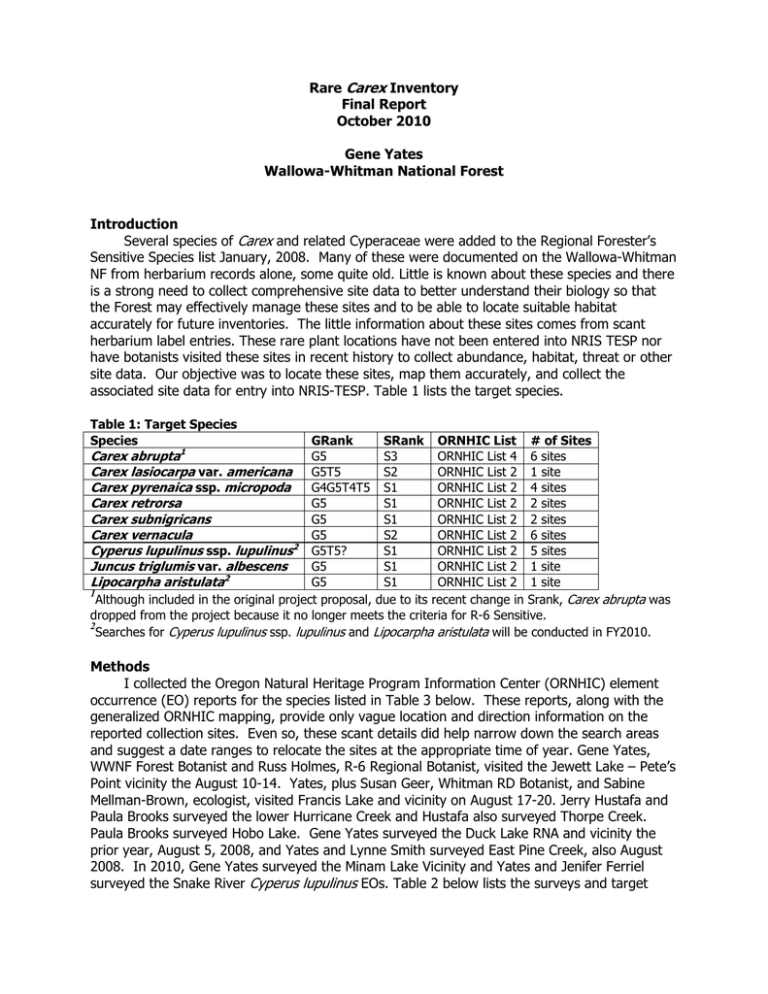
Rare Carex Inventory Final Report October 2010 Gene Yates Wallowa-Whitman National Forest Introduction Several species of Carex and related Cyperaceae were added to the Regional Forester’s Sensitive Species list January, 2008. Many of these were documented on the Wallowa-Whitman NF from herbarium records alone, some quite old. Little is known about these species and there is a strong need to collect comprehensive site data to better understand their biology so that the Forest may effectively manage these sites and to be able to locate suitable habitat accurately for future inventories. The little information about these sites comes from scant herbarium label entries. These rare plant locations have not been entered into NRIS TESP nor have botanists visited these sites in recent history to collect abundance, habitat, threat or other site data. Our objective was to locate these sites, map them accurately, and collect the associated site data for entry into NRIS-TESP. Table 1 lists the target species. Table 1: Target Species Species GRank SRank ORNHIC List # of Sites G5 S3 ORNHIC List 4 6 sites G5T5 S2 ORNHIC List 2 1 site G4G5T4T5 S1 ORNHIC List 2 4 sites G5 S1 ORNHIC List 2 2 sites G5 S1 ORNHIC List 2 2 sites G5 S2 ORNHIC List 2 6 sites G5T5? S1 ORNHIC List 2 5 sites G5 S1 ORNHIC List 2 1 site G5 S1 ORNHIC List 2 1 site 1 Although included in the original project proposal, due to its recent change in Srank, Carex abrupta was dropped from the project because it no longer meets the criteria for R-6 Sensitive. 2 Searches for Cyperus lupulinus ssp. lupulinus and Lipocarpha aristulata will be conducted in FY2010. Carex abrupta1 Carex lasiocarpa var. americana Carex pyrenaica ssp. micropoda Carex retrorsa Carex subnigricans Carex vernacula Cyperus lupulinus ssp. lupulinus2 Juncus triglumis var. albescens Lipocarpha aristulata2 Methods I collected the Oregon Natural Heritage Program Information Center (ORNHIC) element occurrence (EO) reports for the species listed in Table 3 below. These reports, along with the generalized ORNHIC mapping, provide only vague location and direction information on the reported collection sites. Even so, these scant details did help narrow down the search areas and suggest a date ranges to relocate the sites at the appropriate time of year. Gene Yates, WWNF Forest Botanist and Russ Holmes, R-6 Regional Botanist, visited the Jewett Lake – Pete’s Point vicinity the August 10-14. Yates, plus Susan Geer, Whitman RD Botanist, and Sabine Mellman-Brown, ecologist, visited Francis Lake and vicinity on August 17-20. Jerry Hustafa and Paula Brooks surveyed the lower Hurricane Creek and Hustafa also surveyed Thorpe Creek. Paula Brooks surveyed Hobo Lake. Gene Yates surveyed the Duck Lake RNA and vicinity the prior year, August 5, 2008, and Yates and Lynne Smith surveyed East Pine Creek, also August 2008. In 2010, Gene Yates surveyed the Minam Lake Vicinity and Yates and Jenifer Ferriel surveyed the Snake River Cyperus lupulinus EOs. Table 2 below lists the surveys and target species. Surveys were conducted via the intuitive controlled method directed to the target species. These surveys have been entered into the NRIS TESP-INPA application and listed below in Table 1. Table 2. Rare Carex Inventory - NRIS TESP-INPA Survey ID and Target Species Survey ID Survey Name Target Species Dates Surveyed Acres 061605S0004 Pete's Point-Polaris Pass Carex subnigricans 8/102009 – 87 Carex vernacula 8/13/2009 061605S0003 Francis Lake-Hurricane Carex capillaris 8/17/2009 – 71 Divide Carex saxatilis 8/20/2009 Carex subnigricans Juncus triglumis var. albescens 061605S0005 Thorpe Creek Carex capillaris 9/07/2009 – 91 Map 9/09/2009 061604S0007 Duck Lake RNA Carex lasiocarpa 8/05/2008 25 var. americana 061607S0001 East Pine Creek – C. Carex retrorsa 8/27/2008 22 retrorsa 061605S0006 Hobo Lake Carex vernacula 9/01/2009 25 061605S0007 Chimney Lake Carex pyrenaica 9/03/2009 061605S0008 Laverty Lake var. micropoda 061605S0009 Hurricane Creek Carex capillaris 08/27/2009 2 061605S0011 Minam Lake and Vicinity Carex vernacula 08/03/2010 28 Carex pyrenaica 08/04/2010 var. micropoda 061604S0040 Snake River Hells Canyon Cyperus lupulinus 09/20/2010 60 var. lupulinus 09/23/2010 Results We relocated 11 of 14 element occurrences scheduled for inventory in 2009. Although we were unable to locate 3 EOs, we did locate sites for each species listed in Table 1 that were scheduled for inventory in 2009. Table 3 lists the element occurrences of sites surveyed in 2009 and 2010 and, if relocated, their NRIS TESP-INPA ID. In 2010 we located 5 of 8 occurrences. Table 3. Target EO Survey Results Species Carex capillaris Carex capillaris Carex capillaris Carex capillaris Carex lasiocarpa var. americana Carex pyrenaica ssp. micropoda Carex pyrenaica ssp. micropoda Carex pyrenaica ssp. micropoda Last Observation 1992-07-31 1944-07-24 1994-08-08 1990-08-29 Survey Result Relocated Did Not Survey Relocated Did Not Locate 1996-07-13 Relocated PMCYP03BA1.3 1971-08-20 Did Not Locate PMCYP03BA1.1 Unknown Did Not Survey 1971-08-10 Relocated EO Code PMCYP032G0.5 PMCYP032G0.3 PMCYP032G0.1 PMCYP032G0.4 NRIS ID 0616050059 PMCYP03721.2 0616040100 PMCYP03BA1.2 0616053008 0616053007 Species Carex pyrenaica ssp. micropoda Carex retrorsa Carex retrorsa Carex saxatilis Carex subnigricans Carex subnigricans Carex vernacula Carex vernacula Carex vernacula Carex vernacula Carex vernacula Carex vernacula Cyperus lupulinus ssp. lupulinus Juncus triglumis var. albescens EO Code Last Observation Survey Result 0616040563 1933-07-28 1996 1992-08-18 1992-07-31 1992-07-31 1991-09-26 1970-08-28 1915-09-03 1990-08-29 1974-08-30 1971-08-20 1975-09-03 1997-09-02 1998-07-14 2006-06-29 2006-06-30 2006-06-30 Did Not Locate Did Not Locate Relocated Relocated Relocated Relocated Relocated Did Not Survey Did Not Survey Did Not Survey Relocated Relocated Relocated Relocated Relocated Did Not Survey Relocated 616050058 1992-07-31 Relocated NRIS ID PMCYP03BA1.4 PMCYP03BJ0.4 PMCYP03BJ0.3 PMCYP03C10.1 PMCYP03D90.6 PMCYP03D90.5 PMCYP03EC0.8 PMCYP03EC0.9 PMCYP03EC0.10 PMCYP03EC0.6 PMCYP03EC0.7 PMCYP03EC0.5 PMCYP061Z1.1 PMCYP061Z1.2 PMCYP061Z1.3 PMCYP061Z1.4 PMCYP061Z1.5 PMJUN01060.1 0616070003 0616050053 0616050060 0616050052 0616053006 0616050600 0616050051 0616040561 0616040560 0616040561 We also discovered several new locations of the target species listed above as well as non-target, R-6 sensitive species: Carex nardina, Carex micropoda, Carex pelocarpa, Townsendia montana, and Thalictrum alpinum var. hebetum. Non-target sensitive plant site discoveries are listed below in Table 4. Table 4. New Sensitive Plant Discoveries Species Carex atrosquama NRCS Code CAATA EO Number New Site Carex media CAME9 New Site 0616053009 Carex nardina CANA2 New Site 0616050056 Carex pelocarpa CAPE5 New Site 0616050055 Carex pyrenaica ssp. micropoda CAPYM 2 New Sites 0616050054 0616050601 Carex subnigricans CASU7 New Site 0616050050 Cyperus lupulinus var. lupulinus CALUL Thalictrum alpinum var. hebetum Townsendia montana THALH Expanded EOs 0616040561 0616040560 0616040561 0616040563 Expanded EO PDRAN0M012.002 New Site 0616050057 TOMO NRIS ID Discussion Carex subnigricans - We found both historic locations and in addition located a third, previously unreported site. At two sites Carex subnigricans was locally very abundant and even dominant in places. A rhizomatous plant, C. subnigricans was found in monocultures near the shoreline of Jewett Lake and Francis Lake. The Francis Lake population, in particular, is as vast as to be uncountable and its size difficult even to estimate. Numerous smaller patches were located south of the lake in the meadows of the glacial valley. With the addition of one new site, found along the shoreline Jewett Lake, there are only 3 known sites for C. subnigricans in the Wallowa Mountains. There is likely much more suitable habitat for Carex subnigricans in the Wallowa Mountains. Carex subnigricans suitable habitat exists in moist-mesic meadows and along lakes and streams - features which abound in the Wallowa Mountains. Moreover, the plant is small, inconspicuous and, from a standing height, resembles, with its single, dark spike, the genus Eleocharis. Most small sedges are likely easily overlooked; perhaps more so with Carex subnigricans. Carex pyrenaica ssp. micropoda – One historical site was relocated but, despite climbing up two of the peak’s ridges and down a third, we failed to relocate the EO reported from the “high, dry slopes” of Pete’s Point. Brooks did relocate C. pyrenaica ssp. micropoda at Hobo Lake. One new site was found by Geer and Mellman-Brown on Hurricane Divide south of Francis Lake. Carex pyrenaica ssp. micropoda was not usually found in abundance. Only a few plants were documented at Hurricane Divide. (Note: Carex pyrenaica ssp. micropoda has now been reclassified as C. micropoda.) The Carex pyrenaica ssp. micropoda at “highest Eagle Cap Mountains” was not located (did not survey due to distance and difficulty of terrain.) A new site of C. pyrenaica ssp. micropoda was located on the east side of the divide between Minam Lake and the upper Lakes Basin. This site was relatively well populated. The habitat is unusual; it was found within the relatively stable interstices of boulder talus. Some plants were located outside the boulder talus on fellfield communities. Ample habitat exists in this high country in the vicinity of the Eagle Cap, and I suspect more patches of this obscure sedge are present. Carex vernacula - Another high elevation subalpine-alpine species of rocky substrates, C. vernacula was found at both sites we attempted to relocate. We did not attempt to relocate 3 sites: one was deemed to remote and too vaguely mapped to invest the time and funding to relocate. Two other C. vernacula EOs are in areas (Ice Lake and the ridge extending north from Ice Lake) that might be located during a recreational excursion. A fourth C. vernacula site at Minam Lake was searched in FY 2010. This site was located on glacial moraine deposits south of Minam Lake. This site occupies little more than 0.1 acre. But otherwise appears in fine condition. We observed ample pika habitat including several pikas. Carex capillaris – Carex capillaris was known historically from 4 sites in the Wallowa Mountains. We relocated 3 EOs and did not attempt the fourth, because the site description (“Lostine River – Wallowa Mountains”) was too vague to narrow the survey to a particular area. At Francis Lake, we extended the site along the western shore southward in 8 discrete patches. Carex retrorsa – Carex retrorsa was located and mapped along East Pine Creek flowing south from the Wallowa Mountains. Relatively large and showy, C. retrorsa is easily recognized. We extended this site both ustream and downstream (north and south) from the original site report. Another reported site (of one plant) on Eagle Creek was not relocated and may have been washed out during the floods and high runoff of 1996-97. Other suitable habitat for C. retrorsa likely exists along the numerous streams draining the Wallowa Mountains. Carex lasiocarpa var. americana – This species was known from one site at the southeast corner of Duck Lake. I visited Duck Lake in August 2008 to relocate and map the site. In addition to locating the species at the southeast corner, I was able to map a near continuous band of the plant around the lake. It grows on floating sedge/sphagnum peat and can be found in association with Carex limosa, and sundews (Drosera anglica). Often, the plant forms extensive monocultures. In a fen/meadow to the west of the lake, I mapped a second large stand of Carex lasiocarpa var. americana and found a third patch in another meadow just north of this stand. Between the three sites, there are tens of thousands ramets of this rhizomatous sedge; however, it remains one of only two occurrences east of the Cascade Mountains in Oregon. Carex saxatilis – One of the more interesting sedges encountered in 2009, Carex saxatilis was relocated at each of the points around Francis Lake previously mapped by the Oregon Natural Heritage Information Center. This sedge, a member of the Vesicariae (the bladder sedges) grows in several patches around Francis Lake, yet is known from only one other spot in NE Oregon. Juncus triglumis var. albescens – The only known site of Juncus triglumis var. albescens was discovered in 1992 by Peter Zika and Ed Alverson along the western shore of Francis Lake. We relocated this small patch and expanded the site to 5 small patches along the west and southwest shore. Given the diminutive stature of this plant, it is likely this plant may have been overlooked and may be present in similar habitats at other locations in the Wallowa Mountains. Cyperus lupulinus var. lupulinus (syn. Cyperus lupulinus) – Four of the five existing element occurrences were visited in September 2010. We greatly expanded both the areal extent and population estimates at each site. Due to their proximity, Oregon EOs 1 and 3 have been combined as one NRIS element occurrence. Encroaching blackberry was present at the Deep Creek site (EO 5) although the population is not immediately at risk. Most sites appear fairly stable, with no obvious impacts or threats. One serendipitous discovery during the Cyperus site visits was the discovery of Spartina pectinata growing along the banks of the Snake River. Spartina pectinata was last reported on the Snake River by William Cusick (who called it as Spartina cynosuroides) in 1890 at a location now inundated by the Hells Canyon Dam. Only four other Spartina pectinata sites are known from Oregon, and all are reported prior to 1932. One site the mouth of the Deschutes River is presumably also inundated by a reservoir. Spartina pectinata is not ranked by Natureserve in Oregon, but is S2 in Washington. Afterword The high country of the Wallowa Mountains poses unique problems to inventory. For species with habitat among the cirques, ridges and peaks, apparently ample habitat exists; however, herculean efforts are required to adequately inventory even small areas. Much habitat remains to be searched for species such as Carex vernacula, Carex micropoda, Carex nardina, and Kobresia species. We can be comforted that these species’ habitats have, for now, few threats facing them. The decline of permanent snowfields, whose melt water irrigates these sedges habitats, is a continuing threat to these species. Acknowledgements: I would like to extend special thanks to Russ Holmes, past R-6 Regional Botanist, for his eyes, assistance and support on the Jewett Lake, Pete’s Point, and Polaris Pass surveys. Thanks to Susan Geer and Sabine Mellman-Brown (wonderful knowledge of Rocky Mountain alpine sedges) for their assistance with the Francis Lake surveys – and especially the chocolate. Thanks to Jenifer Ferriel her assistance with the Cyperus lupulinus surveys. This project was made possible by funding from the R-6 ISSSP program – thank you! Jewitt Lake – Pete’s Point Carex subnigricans habitat Carex subnigricans Pete’s Point Survey High, dry slopes below Pete’s Point Carex vernacula habitat Carex vernacular Glacial Valley with Francis Lake Francis Lake Carex capillaris – Juncus triglumis habitat Carex capillaris inflorescence Juncus triglumis var. albescens Townsendia montana Hurricane Divide
![[[1]] Copy*1 H.M.S. Erebus Berkeley Sound Falkl[a]nd Nov[ember](http://s3.studylib.net/store/data/007561645_2-e073f5cfe18af2a59c8b5c1b789daea4-300x300.png)
